No witty comments or pithy observations from me today. Just the Weekend Service Advisory, ma’am.
1
From 12:01 a.m. Saturday, September 15 to 5 a.m. Monday, September 17, there are no 1 trains between 14th Street and South Ferry. Customers may take the 2 or 3 between 14th Street and Chambers Street. There are free shuttle buses operating between Chambers Street and South Ferry. This is due to Port Authority underpinning work at the WTC site for the new PATH station.
2
From 12:01 a.m. Saturday, September 15 to 5 a.m. Monday, September 17, 2 and 3 trains run local between 96th Street and Chambers Street due to Port Authority underpinning work at the WTC site for the new PATH station.
From 6 a.m. Saturday, September 15 to 9 p.m. Sunday, September 16, Manhattan-bound 2 trains run express from East 180th Street to 3rd Avenue due to rail installation south of East 180th Street station.
3
From 6 a.m. to 7:30 a.m., Sunday, September 16, 3 train service is replaced by M7, M102 and shuttle buses between 135th Street and 148th Street due to switch renewal south of 148th Street-Lenox Avenue.
4
At all times through mid-November, Manhattan-bound 4 trains skip Mosholu Parkway due to station rehabilitation.
From 12:01 a.m. Saturday, September 15 to Monday, September 17, no 4 train service at Mosholu Parkway due to station rehabilitation. Free shuttle buses operate between Woodlawn and Bedford Park Blvd.
From 12:01 a.m. Saturday, September 15 to Monday, September 17, Bronx-bound 4 trains run express from 125th Street to Burnside Avenue due to track chip-out north of 149th Street-Grand Concourse.
6
From 4 a.m. Saturday, September 15 to 10 p.m. Sunday, September 16, Bronx-bound 6 trains run express from Hunts Point Avenue to Parkchester due to track panel installation at Whitlock Avenue. (The last stop for some Bronx-bound 6 trains will be 3rd Avenue.)
A
From 12:01 a.m. Saturday, September 15 to Monday, September 17, free shuttle buses and shuttle train service replace the A between Howard Beach-JFK Airport and the Rockaways due to track panel installation south of Howard Beach-JFK Airport station.
E
From 12:30 a.m. Saturday, September 15 to 4:30 a.m. Monday, September 17, Manhattan-bound E trains run express from Roosevelt Avenue to Queens Plaza due to track chip-out south of Queens Plaza station.
From 12:01 a.m. Saturday, September 15 to 5 a.m. Monday, September 17, Manhattan-bound E trains run express from Van Wyck to Roosevelt Avenue due to track conduit work south of Kew Gardens-Union Turnpike station.
F
From 12:01 a.m. Saturday, September 15 to 5 a.m. Monday, September 17, Manhattan-bound F trains run express from Parsons Blvd. to Forest Hills-71st Avenue due to track conduit work south of Kew Gardens-Union Turnpike station.
G
From 8:30 p.m. Friday, September 14 to 5 a.m. Monday, September 17, (and until further notice), there is no G train service between Forest Hills-71st Avenue and Court Square due to track chip-out south of Queens Plaza. Customers should take the E or R.
NR
From 12:01 a.m. Saturday, September 15 to 5 a.m. Monday, September 17, Manhattan-bound NR trains are rerouted over the Manhattan Bridge from DeKalb Avenue to Canal Street due to tunnel rehabilitation south of Prince Street station.
N
From 12:01 a.m. Saturday, September 15 to 5 a.m. Monday, September 17, Manhattan-bound N trains run on the D line from Coney Island-Stillwell Avenue to 36th Street (Brooklyn) due to track panel installation between 86th Street and 59th Street stations.
Q
From 12:30 a.m. Saturday, September 15 to 4:30 a.m. Monday, September 17, there are no Q trains between 57th Street and 42nd Street due to a track chip-out south of Queens Plaza station. Customers may take the N or R instead.
R
From 5 a.m. to midnight Saturday, September 15 and Sunday, September 16, R trains skip 5th Avenue, Lexington Avenue, and Queens Plaza in both directions due to roadbed replacement/chip-out work south of Queens Plaza. For 5th Avenue and Lexington Avenue, customers should transfer to the N at 57th-7th Avenue. For Queens Plaza, customers should take the E.
From 5 a.m. to midnight Saturday, September 15 and Sunday, September 16, Manhattan-bound R trains run express from Forest Hill-71st Avenue to Roosevelt Avenue due to track conduit work south of Kew Gardens-Union Turnpike station.
RW
The Cortlandt Street Station is closed until further notice while the Port Authority of New York and New Jersey continues to build on the WTC site.


 Only half of my headline for this post is true. Guess which half.
Only half of my headline for this post is true. Guess which half.




 With the Official End of Summer in the rear view mirror, my weekly Friday afternoon recaps of the MTA’s weekend service alerts return. But first, some housekeeping.
With the Official End of Summer in the rear view mirror, my weekly Friday afternoon recaps of the MTA’s weekend service alerts return. But first, some housekeeping.